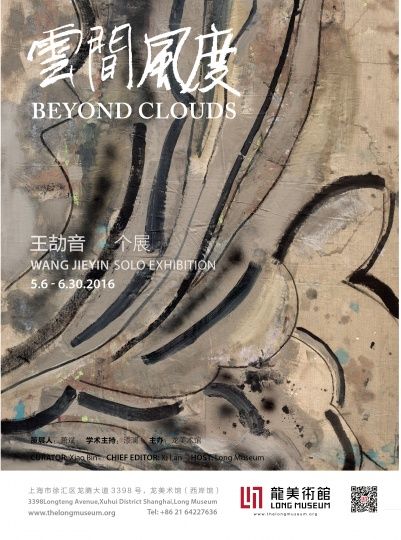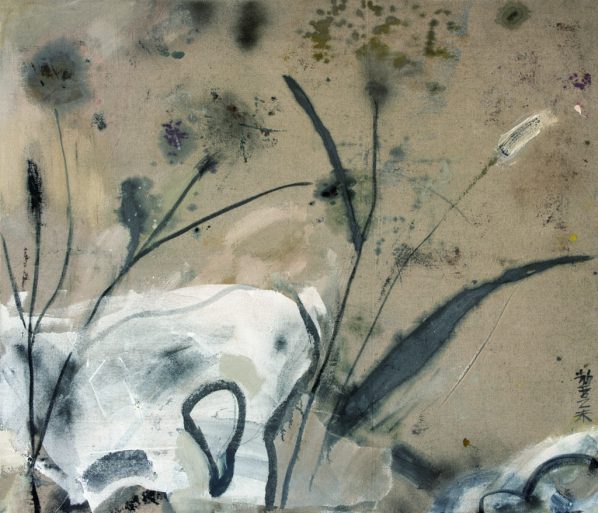
The artistic creations of Wang Jieyin take its law from ‘nature’, freely transforming between varieties forms of art like block print, oil painting, ink and wash, etc. His explorations on easel originate in primitive landscapes and images including strolling clouds and floating water, flowers and plants, searching for literati temperament that is full of ‘image forms’ with strokes of brushwork and constructing of modality. The crossing-age sophisticated grace drifts between tradition and contemporary era.
Regarding the spirit of Chinese ancient painting, a number of works of ancient masters were so much contemporary. Considering the painting of Zhu Da, Kun Can, Mei Qing, we find their elements of modernity are no less than explorations of western modern arts, either in artistic language or form constitution. In this point of view, traditional paintings could be taken as either figural art or abstract art, and even taken as a fusion of both. Searching for the antique tastes in the contemporariness of forms and materials, Wang Jieyin’s paintings deconstruct the landscape of moutain and water into stylistic symbols, which echoes with the spirits of traditional paintings.

Wang Jieyin, White Rock, 2015; Acrylic and oil on canvas
Styles and images will constitute the domains of Wang Jieyin’s painting in the dimension of time and dimension of spirit. The collections of Guan Liang’s and Lin Fengmian’s masterpieces in Long Musuem are the mirrors of the style of Wang Jieyin’s early works. And the experimental landscape works of Wang Jieyin after the year of 2000, will be juxtaposed together with original master pieces of Zhu Da, Kun Can, Luo Pin, and Wang Yuanqi, demonstrating the contemporariness of ancient paintings and litarati tastes of contemporary experimental arts. Both of them will complete their conversions into each other in a same domain.
Wang Jieyin’s artworks emphasize spirit than pattern, and think highly of the self entertainment than education. As for Wang Jieyin in himself, is one master with low profile character, and is accustomed to hiding in big city. Wang’s artworks inherit the traditional artistic conception and utilize the contemporary material. Wang is called “Literati Painter” by critics, the feature of his artworks is in the same strain with the pursuit of traditional scholar. This exhibition would take the literati painting as the prologue and carry out one ancient and modern dialogue.

Wang Jieyin, Colored Clouds, 2014; Acrylic and oil on canvas
“Beyond Clouds – Wang Jieyin” attempt to construct a new scene, and this scene would take the “Ink Lotus” of badashanren; “Mountains-and-waters Painting for Zhou Lianggong” of Kun Chan; “The Annex Scenery”of Gong Xian; “Whistling of the Wind in the Pines”of Lin Fengmian; “Steintor”of Guan Liang; “Moon over the Peaceful Lake in Autumn” of Qiu Ti and Wang’s artworks of different dates in the same scene. In Long Museum, this exhibition would conduct the experience of mental resonance and textures exchange. Through Wang’s artworks, we can succeed in experiencing the interesting prospect in different angle. At the same time, by the traditional artworks, we can succeed in having the clear interpretation of Wang’s artworks.
This exhibition is the stage for traditional artworks in contemporary pattern. From the “western painting movement” of republic of China era to Wang’s painting pursuing ancient prospect with contemporary pattern and material. All in all, “Beyond Clouds – Wang Jieyin” is a new exploration.
About the exhibition
Curator: Xiao Bin
Date: May 6 – June 30, 2016
Venue: Long Museum (West Bund)
Courtesy of the artist and Long Museum, for further information please visit http://thelongmuseum.org.




























